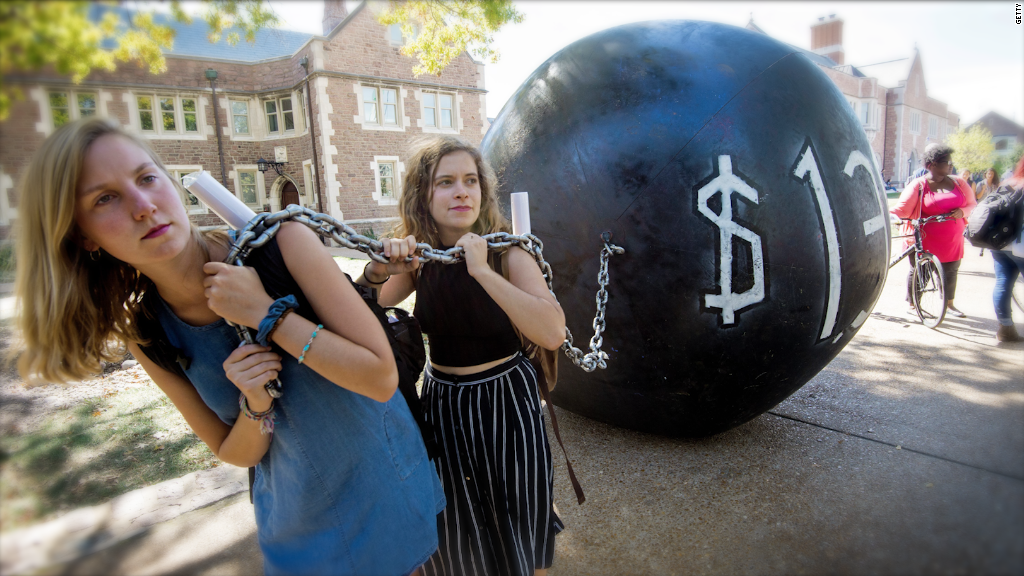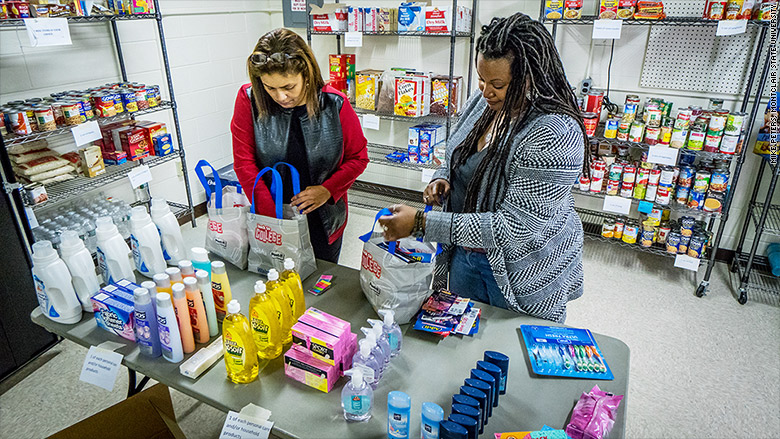
Montclair State University's food pantry is tucked away down a maze of hallways in the student center. Like the hunger problem on campus itself, the pantry is not quite out in the open.
It opened on the New Jersey college's campus in April, after administrators started hearing from students who said they were hungry and didn't have enough money for food. They surveyed students, finding that more than half said they or someone they know experiences "food insecurity" -- the lack of access to affordable, nutritious food.
On one Thursday in December, 33 students visited the food pantry, taking what they need to help make ends meet. They left with bread, cereal, milk, spaghetti, canned vegetables, as well as personal items like shampoo and soap.
"Even if you don't hear about hunger being a problem, there's probably a population on campus in need," said Megan Breitenbach, a student who volunteers at Montclair State's pantry.
Related: This could help fix America's student debt crisis
The number of food pantries on college campuses is exploding. While there's no official count, membership in the College and University Food Bank Alliance has quadrupled in the past two years. It currently has 398 members.
"Do I think there's always been a need? I would say yes. But students are being more vocal about it," said Fatima deCarvalho, the Associate Dean of Students at Montclair State.
Enrollment at the public university is at a record high. The majority of its 21,000 students don't live on campus and don't have a meal plan. In order to take advantage of the campus's food pantry, the financial aid office must first verify their need, though eligibility is considered on a case-by-case basis. Many students need a leg up for the time being because of an extenuating circumstance, deCarvalho said.
While the economy has rebounded, the cost of college continues to rise faster than income. The average total cost rose 10% over the past five years at public colleges and by 12% at private institutions. Median family income rose just 7% over the same time period.
Related: Why rich colleges still charge tuition
A new report shows that the college campus hunger problem goes far beyond a few sad stories. It surveyed more than 3,000 students at a mix of 34 community and four-year colleges, finding that 48% experienced food insecurity in the past 30 days.
The data suggests that hunger is more common among college students than the U.S. population as a whole, in which 14% of households experience food insecurity each year, according to the government.

"A majority of students who are food insecure were also working and receiving financial aid," said Clare Cady, an author of the report and co-founder of CUFBA.
The study found that 56% of food insecure students were currently employed, more than half received a federal grant, and 18% had received a private scholarship.
"We're talking about students who are doing all the things we'd expect them to do and they're still not able to support themselves while in school," Cady said.
Related: Too poor to pay for college, too rich for financial aid
Across the country, most campus food pantries are funded through donations, but some receive stipends from a school group. They're widespread, but are mostly at public universities. They serve students at big names like Michigan State University, the University of Missouri, Penn State and Syracuse, as well as smaller community colleges.
At Montclair State, the food pantry operates solely on donations. The Alumni Relations and Annual Giving foundation raised $10,000 over the summer and New Jersey-based Inserra Supermarkets gave the pantry a refrigerator and makes regular food donations.
As word has spread, more students are using the pantry.
"But it's still one of those things people don't talk about," said Chris Beckus, another student volunteer.
The pantry itself, a windowless room with fluorescent lights, isn't exactly easy to stumble upon. But those who need it are finding it.
"It would be wonderful if one day we just don't need it anymore," deCarvalho said.
